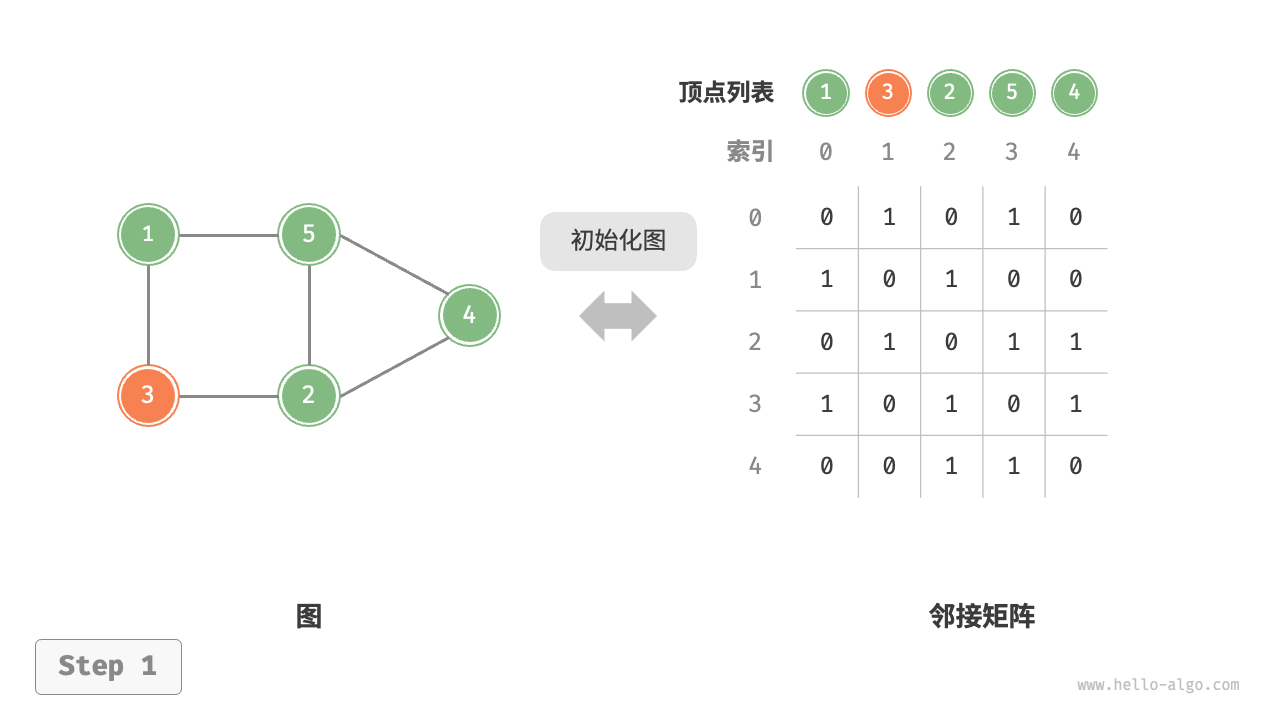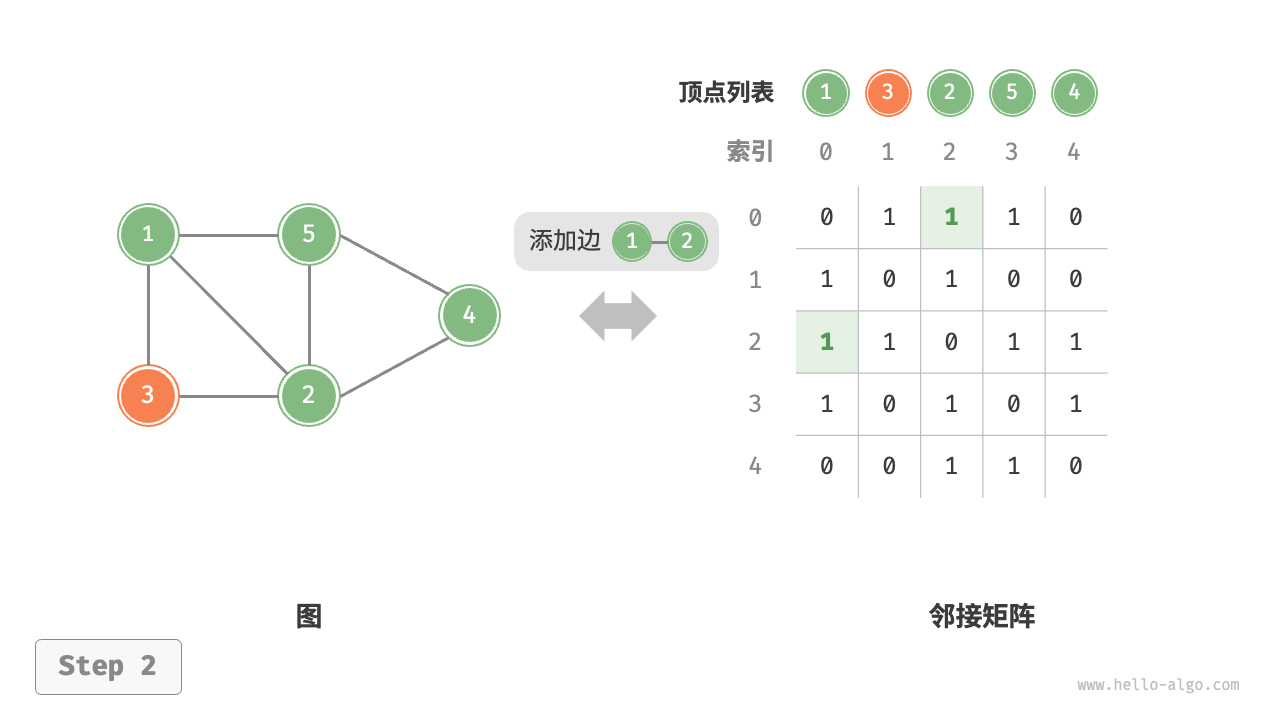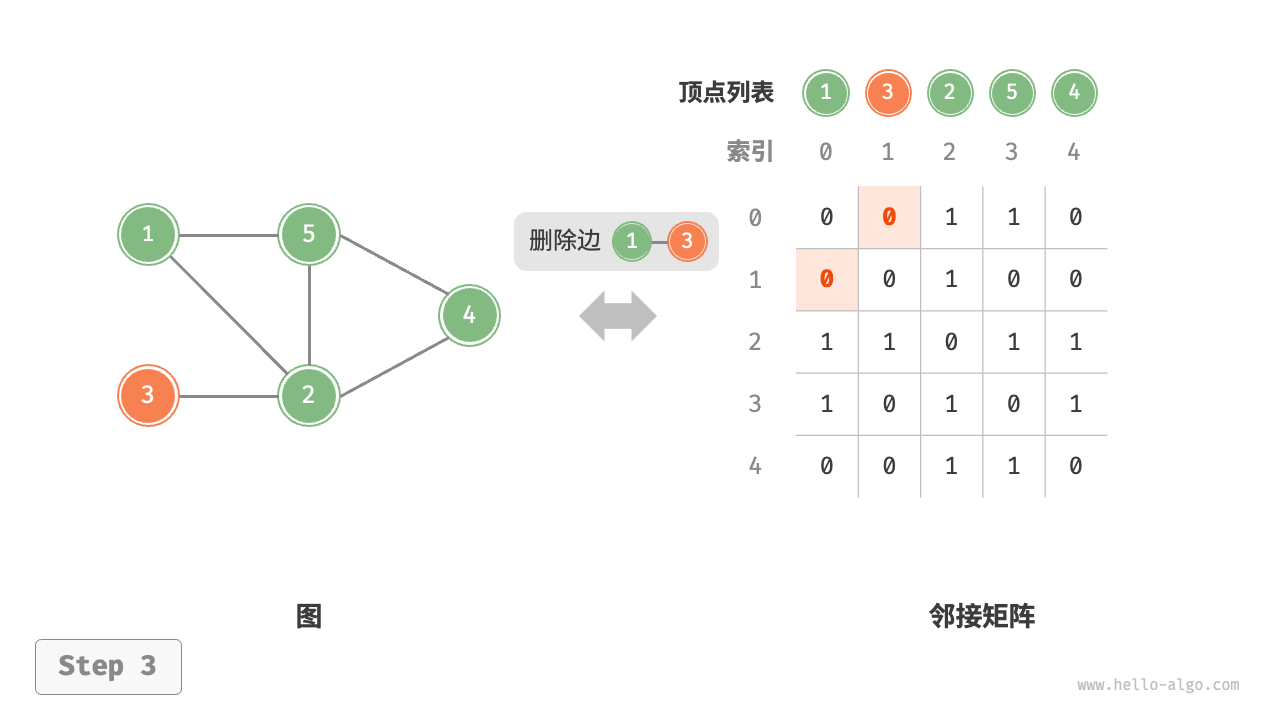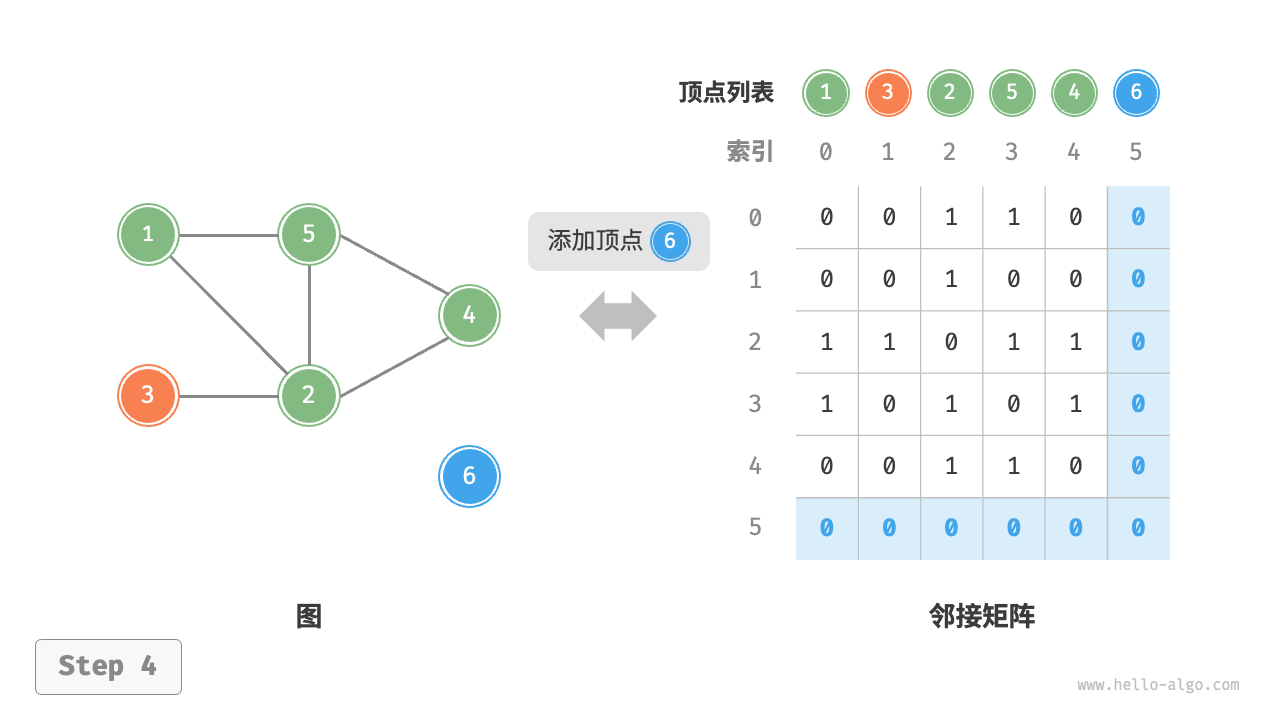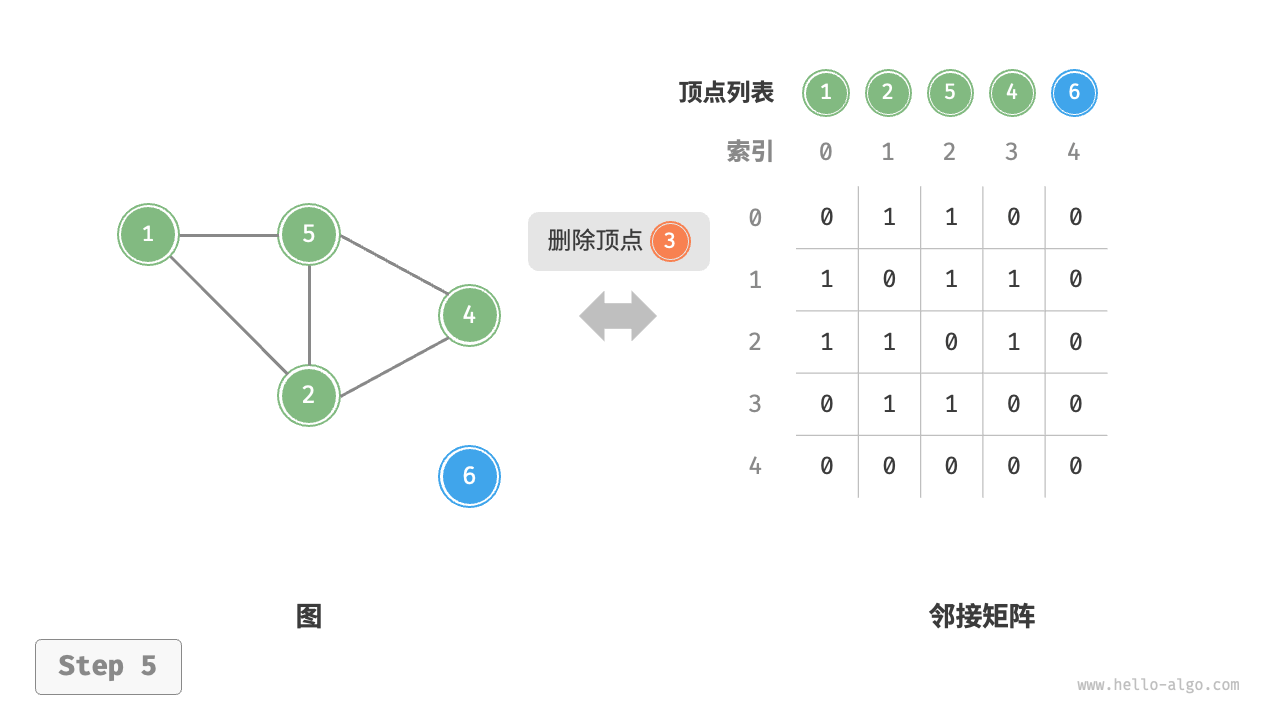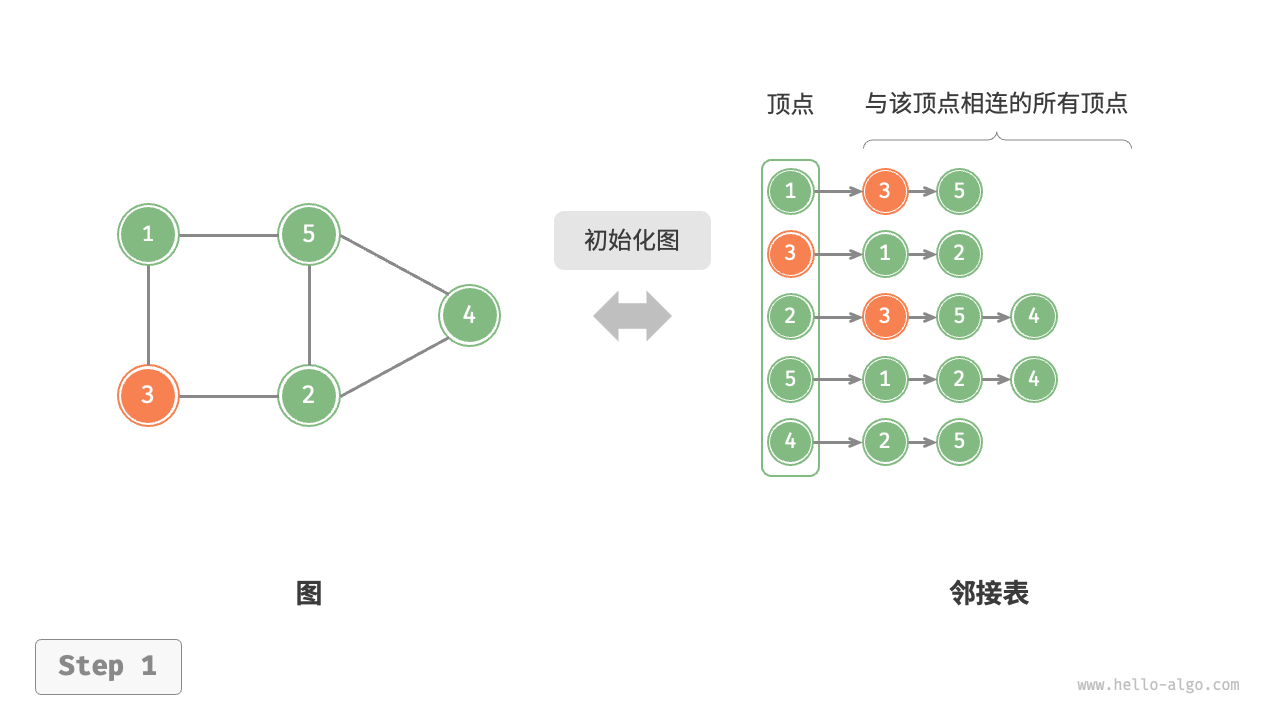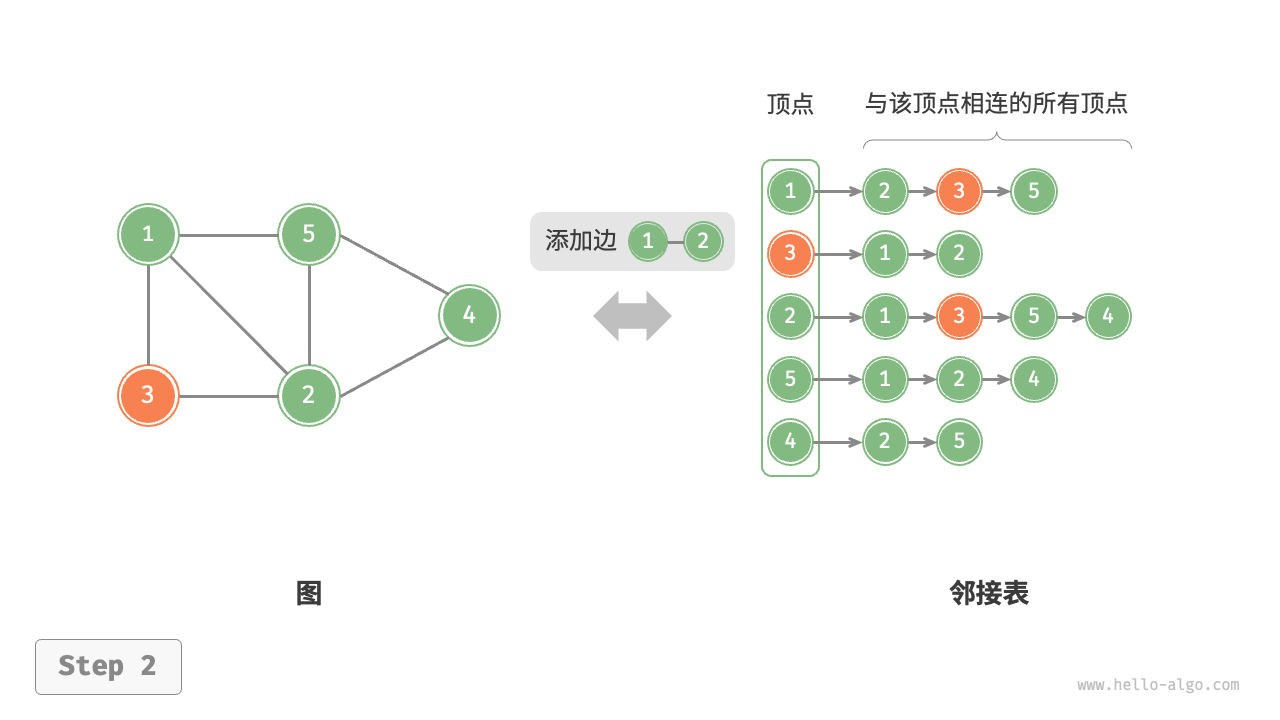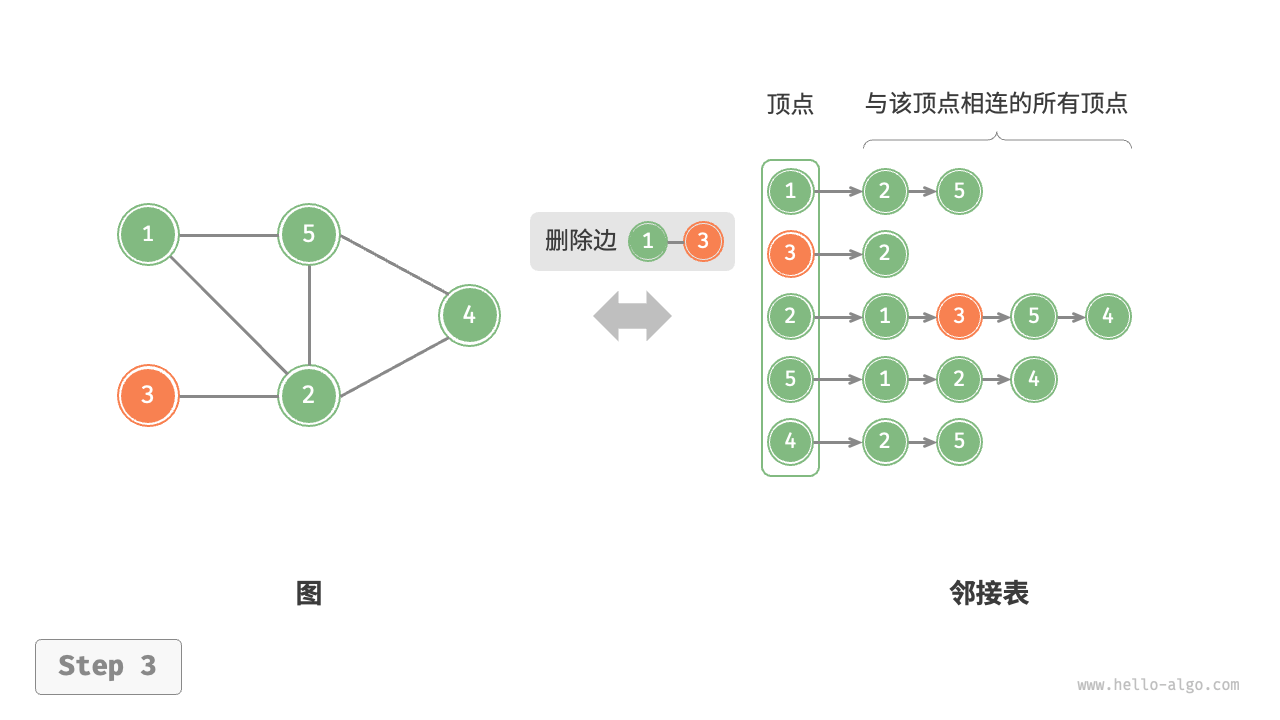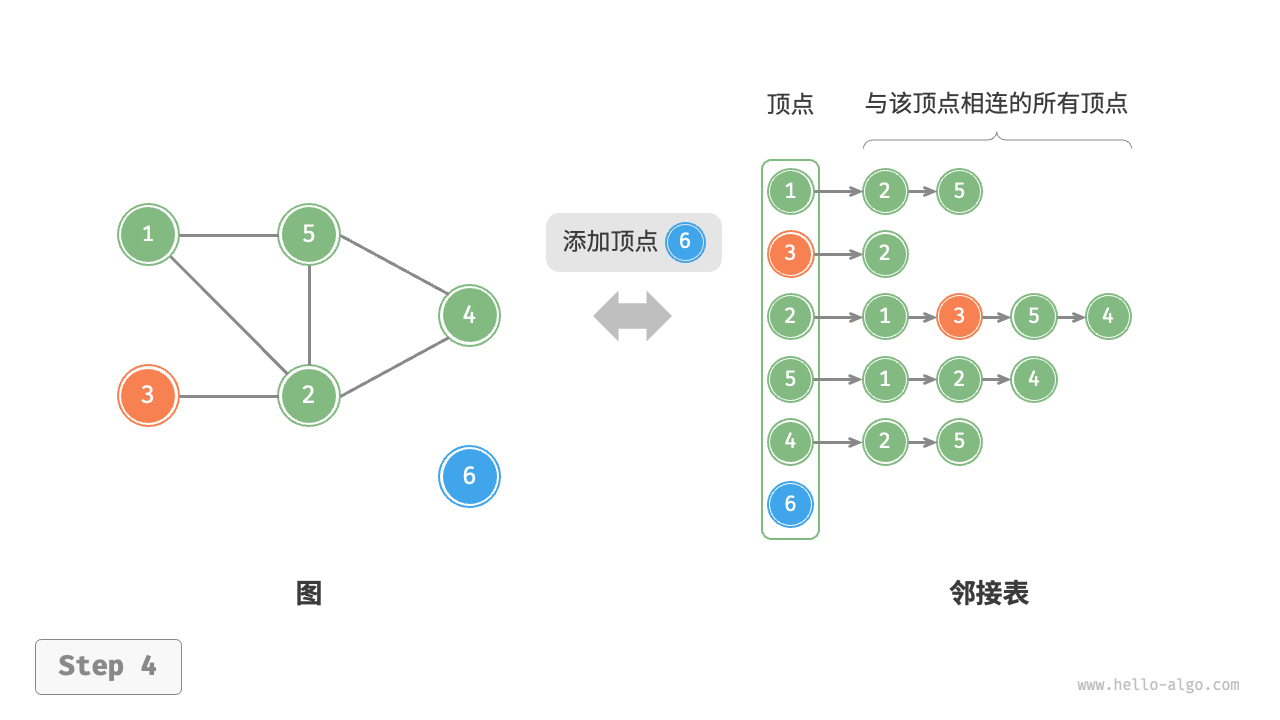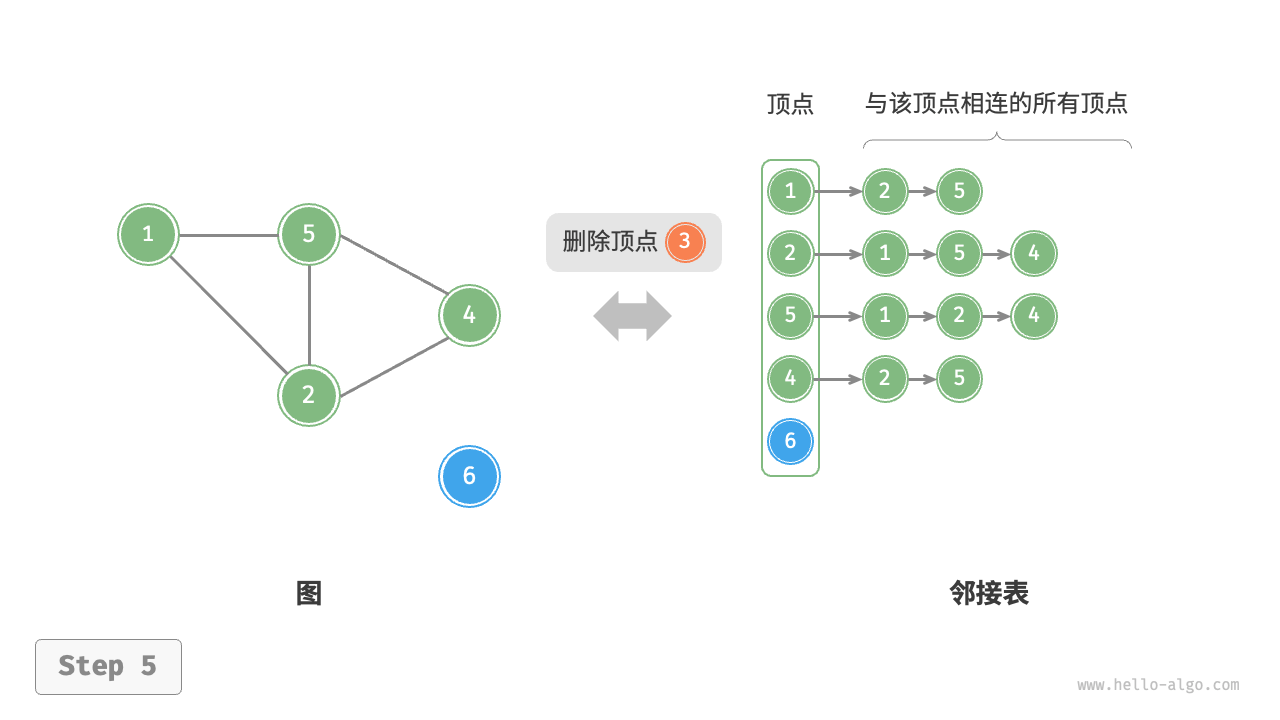9.2 图的基础操作¶
图的基础操作可分为对“边”的操作和对“顶点”的操作。在“邻接矩阵”和“邻接表”两种表示方法下,实现方式有所不同。
9.2.1 基于邻接矩阵的实现¶
给定一个顶点数量为 \(n\) 的无向图,则各种操作的实现方式如图 9-7 所示。
- 添加或删除边:直接在邻接矩阵中修改指定的边即可,使用 \(O(1)\) 时间。而由于是无向图,因此需要同时更新两个方向的边。
- 添加顶点:在邻接矩阵的尾部添加一行一列,并全部填 \(0\) 即可,使用 \(O(n)\) 时间。
- 删除顶点:在邻接矩阵中删除一行一列。当删除首行首列时达到最差情况,需要将 \((n-1)^2\) 个元素“向左上移动”,从而使用 \(O(n^2)\) 时间。
- 初始化:传入 \(n\) 个顶点,初始化长度为 \(n\) 的顶点列表
vertices,使用 \(O(n)\) 时间;初始化 \(n \times n\) 大小的邻接矩阵adjMat,使用 \(O(n^2)\) 时间。
图 9-7 邻接矩阵的初始化、增删边、增删顶点
以下是基于邻接矩阵表示图的实现代码:
graph_adjacency_matrix.py
class GraphAdjMat:
"""基于邻接矩阵实现的无向图类"""
def __init__(self, vertices: list[int], edges: list[list[int]]):
"""构造方法"""
# 顶点列表,元素代表“顶点值”,索引代表“顶点索引”
self.vertices: list[int] = []
# 邻接矩阵,行列索引对应“顶点索引”
self.adj_mat: list[list[int]] = []
# 添加顶点
for val in vertices:
self.add_vertex(val)
# 添加边
# 请注意,edges 元素代表顶点索引,即对应 vertices 元素索引
for e in edges:
self.add_edge(e[0], e[1])
def size(self) -> int:
"""获取顶点数量"""
return len(self.vertices)
def add_vertex(self, val: int):
"""添加顶点"""
n = self.size()
# 向顶点列表中添加新顶点的值
self.vertices.append(val)
# 在邻接矩阵中添加一行
new_row = [0] * n
self.adj_mat.append(new_row)
# 在邻接矩阵中添加一列
for row in self.adj_mat:
row.append(0)
def remove_vertex(self, index: int):
"""删除顶点"""
if index >= self.size():
raise IndexError()
# 在顶点列表中移除索引 index 的顶点
self.vertices.pop(index)
# 在邻接矩阵中删除索引 index 的行
self.adj_mat.pop(index)
# 在邻接矩阵中删除索引 index 的列
for row in self.adj_mat:
row.pop(index)
def add_edge(self, i: int, j: int):
"""添加边"""
# 参数 i, j 对应 vertices 元素索引
# 索引越界与相等处理
if i < 0 or j < 0 or i >= self.size() or j >= self.size() or i == j:
raise IndexError()
# 在无向图中,邻接矩阵关于主对角线对称,即满足 (i, j) == (j, i)
self.adj_mat[i][j] = 1
self.adj_mat[j][i] = 1
def remove_edge(self, i: int, j: int):
"""删除边"""
# 参数 i, j 对应 vertices 元素索引
# 索引越界与相等处理
if i < 0 or j < 0 or i >= self.size() or j >= self.size() or i == j:
raise IndexError()
self.adj_mat[i][j] = 0
self.adj_mat[j][i] = 0
def print(self):
"""打印邻接矩阵"""
print("顶点列表 =", self.vertices)
print("邻接矩阵 =")
print_matrix(self.adj_mat)
graph_adjacency_matrix.cpp
/* 基于邻接矩阵实现的无向图类 */
class GraphAdjMat {
vector<int> vertices; // 顶点列表,元素代表“顶点值”,索引代表“顶点索引”
vector<vector<int>> adjMat; // 邻接矩阵,行列索引对应“顶点索引”
public:
/* 构造方法 */
GraphAdjMat(const vector<int> &vertices, const vector<vector<int>> &edges) {
// 添加顶点
for (int val : vertices) {
addVertex(val);
}
// 添加边
// 请注意,edges 元素代表顶点索引,即对应 vertices 元素索引
for (const vector<int> &edge : edges) {
addEdge(edge[0], edge[1]);
}
}
/* 获取顶点数量 */
int size() const {
return vertices.size();
}
/* 添加顶点 */
void addVertex(int val) {
int n = size();
// 向顶点列表中添加新顶点的值
vertices.push_back(val);
// 在邻接矩阵中添加一行
adjMat.emplace_back(vector<int>(n, 0));
// 在邻接矩阵中添加一列
for (vector<int> &row : adjMat) {
row.push_back(0);
}
}
/* 删除顶点 */
void removeVertex(int index) {
if (index >= size()) {
throw out_of_range("顶点不存在");
}
// 在顶点列表中移除索引 index 的顶点
vertices.erase(vertices.begin() + index);
// 在邻接矩阵中删除索引 index 的行
adjMat.erase(adjMat.begin() + index);
// 在邻接矩阵中删除索引 index 的列
for (vector<int> &row : adjMat) {
row.erase(row.begin() + index);
}
}
/* 添加边 */
// 参数 i, j 对应 vertices 元素索引
void addEdge(int i, int j) {
// 索引越界与相等处理
if (i < 0 || j < 0 || i >= size() || j >= size() || i == j) {
throw out_of_range("顶点不存在");
}
// 在无向图中,邻接矩阵关于主对角线对称,即满足 (i, j) == (j, i)
adjMat[i][j] = 1;
adjMat[j][i] = 1;
}
/* 删除边 */
// 参数 i, j 对应 vertices 元素索引
void removeEdge(int i, int j) {
// 索引越界与相等处理
if (i < 0 || j < 0 || i >= size() || j >= size() || i == j) {
throw out_of_range("顶点不存在");
}
adjMat[i][j] = 0;
adjMat[j][i] = 0;
}
/* 打印邻接矩阵 */
void print() {
cout << "顶点列表 = ";
printVector(vertices);
cout << "邻接矩阵 =" << endl;
printVectorMatrix(adjMat);
}
};
graph_adjacency_matrix.java
/* 基于邻接矩阵实现的无向图类 */
class GraphAdjMat {
List<Integer> vertices; // 顶点列表,元素代表“顶点值”,索引代表“顶点索引”
List<List<Integer>> adjMat; // 邻接矩阵,行列索引对应“顶点索引”
/* 构造方法 */
public GraphAdjMat(int[] vertices, int[][] edges) {
this.vertices = new ArrayList<>();
this.adjMat = new ArrayList<>();
// 添加顶点
for (int val : vertices) {
addVertex(val);
}
// 添加边
// 请注意,edges 元素代表顶点索引,即对应 vertices 元素索引
for (int[] e : edges) {
addEdge(e[0], e[1]);
}
}
/* 获取顶点数量 */
public int size() {
return vertices.size();
}
/* 添加顶点 */
public void addVertex(int val) {
int n = size();
// 向顶点列表中添加新顶点的值
vertices.add(val);
// 在邻接矩阵中添加一行
List<Integer> newRow = new ArrayList<>(n);
for (int j = 0; j < n; j++) {
newRow.add(0);
}
adjMat.add(newRow);
// 在邻接矩阵中添加一列
for (List<Integer> row : adjMat) {
row.add(0);
}
}
/* 删除顶点 */
public void removeVertex(int index) {
if (index >= size())
throw new IndexOutOfBoundsException();
// 在顶点列表中移除索引 index 的顶点
vertices.remove(index);
// 在邻接矩阵中删除索引 index 的行
adjMat.remove(index);
// 在邻接矩阵中删除索引 index 的列
for (List<Integer> row : adjMat) {
row.remove(index);
}
}
/* 添加边 */
// 参数 i, j 对应 vertices 元素索引
public void addEdge(int i, int j) {
// 索引越界与相等处理
if (i < 0 || j < 0 || i >= size() || j >= size() || i == j)
throw new IndexOutOfBoundsException();
// 在无向图中,邻接矩阵关于主对角线对称,即满足 (i, j) == (j, i)
adjMat.get(i).set(j, 1);
adjMat.get(j).set(i, 1);
}
/* 删除边 */
// 参数 i, j 对应 vertices 元素索引
public void removeEdge(int i, int j) {
// 索引越界与相等处理
if (i < 0 || j < 0 || i >= size() || j >= size() || i == j)
throw new IndexOutOfBoundsException();
adjMat.get(i).set(j, 0);
adjMat.get(j).set(i, 0);
}
/* 打印邻接矩阵 */
public void print() {
System.out.print("顶点列表 = ");
System.out.println(vertices);
System.out.println("邻接矩阵 =");
PrintUtil.printMatrix(adjMat);
}
}
graph_adjacency_matrix.cs
/* 基于邻接矩阵实现的无向图类 */
class GraphAdjMat {
List<int> vertices; // 顶点列表,元素代表“顶点值”,索引代表“顶点索引”
List<List<int>> adjMat; // 邻接矩阵,行列索引对应“顶点索引”
/* 构造函数 */
public GraphAdjMat(int[] vertices, int[][] edges) {
this.vertices = [];
this.adjMat = [];
// 添加顶点
foreach (int val in vertices) {
AddVertex(val);
}
// 添加边
// 请注意,edges 元素代表顶点索引,即对应 vertices 元素索引
foreach (int[] e in edges) {
AddEdge(e[0], e[1]);
}
}
/* 获取顶点数量 */
int Size() {
return vertices.Count;
}
/* 添加顶点 */
public void AddVertex(int val) {
int n = Size();
// 向顶点列表中添加新顶点的值
vertices.Add(val);
// 在邻接矩阵中添加一行
List<int> newRow = new(n);
for (int j = 0; j < n; j++) {
newRow.Add(0);
}
adjMat.Add(newRow);
// 在邻接矩阵中添加一列
foreach (List<int> row in adjMat) {
row.Add(0);
}
}
/* 删除顶点 */
public void RemoveVertex(int index) {
if (index >= Size())
throw new IndexOutOfRangeException();
// 在顶点列表中移除索引 index 的顶点
vertices.RemoveAt(index);
// 在邻接矩阵中删除索引 index 的行
adjMat.RemoveAt(index);
// 在邻接矩阵中删除索引 index 的列
foreach (List<int> row in adjMat) {
row.RemoveAt(index);
}
}
/* 添加边 */
// 参数 i, j 对应 vertices 元素索引
public void AddEdge(int i, int j) {
// 索引越界与相等处理
if (i < 0 || j < 0 || i >= Size() || j >= Size() || i == j)
throw new IndexOutOfRangeException();
// 在无向图中,邻接矩阵关于主对角线对称,即满足 (i, j) == (j, i)
adjMat[i][j] = 1;
adjMat[j][i] = 1;
}
/* 删除边 */
// 参数 i, j 对应 vertices 元素索引
public void RemoveEdge(int i, int j) {
// 索引越界与相等处理
if (i < 0 || j < 0 || i >= Size() || j >= Size() || i == j)
throw new IndexOutOfRangeException();
adjMat[i][j] = 0;
adjMat[j][i] = 0;
}
/* 打印邻接矩阵 */
public void Print() {
Console.Write("顶点列表 = ");
PrintUtil.PrintList(vertices);
Console.WriteLine("邻接矩阵 =");
PrintUtil.PrintMatrix(adjMat);
}
}
graph_adjacency_matrix.go
/* 基于邻接矩阵实现的无向图类 */
type graphAdjMat struct {
// 顶点列表,元素代表“顶点值”,索引代表“顶点索引”
vertices []int
// 邻接矩阵,行列索引对应“顶点索引”
adjMat [][]int
}
/* 构造函数 */
func newGraphAdjMat(vertices []int, edges [][]int) *graphAdjMat {
// 添加顶点
n := len(vertices)
adjMat := make([][]int, n)
for i := range adjMat {
adjMat[i] = make([]int, n)
}
// 初始化图
g := &graphAdjMat{
vertices: vertices,
adjMat: adjMat,
}
// 添加边
// 请注意,edges 元素代表顶点索引,即对应 vertices 元素索引
for i := range edges {
g.addEdge(edges[i][0], edges[i][1])
}
return g
}
/* 获取顶点数量 */
func (g *graphAdjMat) size() int {
return len(g.vertices)
}
/* 添加顶点 */
func (g *graphAdjMat) addVertex(val int) {
n := g.size()
// 向顶点列表中添加新顶点的值
g.vertices = append(g.vertices, val)
// 在邻接矩阵中添加一行
newRow := make([]int, n)
g.adjMat = append(g.adjMat, newRow)
// 在邻接矩阵中添加一列
for i := range g.adjMat {
g.adjMat[i] = append(g.adjMat[i], 0)
}
}
/* 删除顶点 */
func (g *graphAdjMat) removeVertex(index int) {
if index >= g.size() {
return
}
// 在顶点列表中移除索引 index 的顶点
g.vertices = append(g.vertices[:index], g.vertices[index+1:]...)
// 在邻接矩阵中删除索引 index 的行
g.adjMat = append(g.adjMat[:index], g.adjMat[index+1:]...)
// 在邻接矩阵中删除索引 index 的列
for i := range g.adjMat {
g.adjMat[i] = append(g.adjMat[i][:index], g.adjMat[i][index+1:]...)
}
}
/* 添加边 */
// 参数 i, j 对应 vertices 元素索引
func (g *graphAdjMat) addEdge(i, j int) {
// 索引越界与相等处理
if i < 0 || j < 0 || i >= g.size() || j >= g.size() || i == j {
fmt.Errorf("%s", "Index Out Of Bounds Exception")
}
// 在无向图中,邻接矩阵关于主对角线对称,即满足 (i, j) == (j, i)
g.adjMat[i][j] = 1
g.adjMat[j][i] = 1
}
/* 删除边 */
// 参数 i, j 对应 vertices 元素索引
func (g *graphAdjMat) removeEdge(i, j int) {
// 索引越界与相等处理
if i < 0 || j < 0 || i >= g.size() || j >= g.size() || i == j {
fmt.Errorf("%s", "Index Out Of Bounds Exception")
}
g.adjMat[i][j] = 0
g.adjMat[j][i] = 0
}
/* 打印邻接矩阵 */
func (g *graphAdjMat) print() {
fmt.Printf("\t顶点列表 = %v\n", g.vertices)
fmt.Printf("\t邻接矩阵 = \n")
for i := range g.adjMat {
fmt.Printf("\t\t\t%v\n", g.adjMat[i])
}
}
graph_adjacency_matrix.swift
/* 基于邻接矩阵实现的无向图类 */
class GraphAdjMat {
private var vertices: [Int] // 顶点列表,元素代表“顶点值”,索引代表“顶点索引”
private var adjMat: [[Int]] // 邻接矩阵,行列索引对应“顶点索引”
/* 构造方法 */
init(vertices: [Int], edges: [[Int]]) {
self.vertices = []
adjMat = []
// 添加顶点
for val in vertices {
addVertex(val: val)
}
// 添加边
// 请注意,edges 元素代表顶点索引,即对应 vertices 元素索引
for e in edges {
addEdge(i: e[0], j: e[1])
}
}
/* 获取顶点数量 */
func size() -> Int {
vertices.count
}
/* 添加顶点 */
func addVertex(val: Int) {
let n = size()
// 向顶点列表中添加新顶点的值
vertices.append(val)
// 在邻接矩阵中添加一行
let newRow = Array(repeating: 0, count: n)
adjMat.append(newRow)
// 在邻接矩阵中添加一列
for i in adjMat.indices {
adjMat[i].append(0)
}
}
/* 删除顶点 */
func removeVertex(index: Int) {
if index >= size() {
fatalError("越界")
}
// 在顶点列表中移除索引 index 的顶点
vertices.remove(at: index)
// 在邻接矩阵中删除索引 index 的行
adjMat.remove(at: index)
// 在邻接矩阵中删除索引 index 的列
for i in adjMat.indices {
adjMat[i].remove(at: index)
}
}
/* 添加边 */
// 参数 i, j 对应 vertices 元素索引
func addEdge(i: Int, j: Int) {
// 索引越界与相等处理
if i < 0 || j < 0 || i >= size() || j >= size() || i == j {
fatalError("越界")
}
// 在无向图中,邻接矩阵关于主对角线对称,即满足 (i, j) == (j, i)
adjMat[i][j] = 1
adjMat[j][i] = 1
}
/* 删除边 */
// 参数 i, j 对应 vertices 元素索引
func removeEdge(i: Int, j: Int) {
// 索引越界与相等处理
if i < 0 || j < 0 || i >= size() || j >= size() || i == j {
fatalError("越界")
}
adjMat[i][j] = 0
adjMat[j][i] = 0
}
/* 打印邻接矩阵 */
func print() {
Swift.print("顶点列表 = ", terminator: "")
Swift.print(vertices)
Swift.print("邻接矩阵 =")
PrintUtil.printMatrix(matrix: adjMat)
}
}
graph_adjacency_matrix.js
/* 基于邻接矩阵实现的无向图类 */
class GraphAdjMat {
vertices; // 顶点列表,元素代表“顶点值”,索引代表“顶点索引”
adjMat; // 邻接矩阵,行列索引对应“顶点索引”
/* 构造函数 */
constructor(vertices, edges) {
this.vertices = [];
this.adjMat = [];
// 添加顶点
for (const val of vertices) {
this.addVertex(val);
}
// 添加边
// 请注意,edges 元素代表顶点索引,即对应 vertices 元素索引
for (const e of edges) {
this.addEdge(e[0], e[1]);
}
}
/* 获取顶点数量 */
size() {
return this.vertices.length;
}
/* 添加顶点 */
addVertex(val) {
const n = this.size();
// 向顶点列表中添加新顶点的值
this.vertices.push(val);
// 在邻接矩阵中添加一行
const newRow = [];
for (let j = 0; j < n; j++) {
newRow.push(0);
}
this.adjMat.push(newRow);
// 在邻接矩阵中添加一列
for (const row of this.adjMat) {
row.push(0);
}
}
/* 删除顶点 */
removeVertex(index) {
if (index >= this.size()) {
throw new RangeError('Index Out Of Bounds Exception');
}
// 在顶点列表中移除索引 index 的顶点
this.vertices.splice(index, 1);
// 在邻接矩阵中删除索引 index 的行
this.adjMat.splice(index, 1);
// 在邻接矩阵中删除索引 index 的列
for (const row of this.adjMat) {
row.splice(index, 1);
}
}
/* 添加边 */
// 参数 i, j 对应 vertices 元素索引
addEdge(i, j) {
// 索引越界与相等处理
if (i < 0 || j < 0 || i >= this.size() || j >= this.size() || i === j) {
throw new RangeError('Index Out Of Bounds Exception');
}
// 在无向图中,邻接矩阵关于主对角线对称,即满足 (i, j) === (j, i)
this.adjMat[i][j] = 1;
this.adjMat[j][i] = 1;
}
/* 删除边 */
// 参数 i, j 对应 vertices 元素索引
removeEdge(i, j) {
// 索引越界与相等处理
if (i < 0 || j < 0 || i >= this.size() || j >= this.size() || i === j) {
throw new RangeError('Index Out Of Bounds Exception');
}
this.adjMat[i][j] = 0;
this.adjMat[j][i] = 0;
}
/* 打印邻接矩阵 */
print() {
console.log('顶点列表 = ', this.vertices);
console.log('邻接矩阵 =', this.adjMat);
}
}
graph_adjacency_matrix.ts
/* 基于邻接矩阵实现的无向图类 */
class GraphAdjMat {
vertices: number[]; // 顶点列表,元素代表“顶点值”,索引代表“顶点索引”
adjMat: number[][]; // 邻接矩阵,行列索引对应“顶点索引”
/* 构造函数 */
constructor(vertices: number[], edges: number[][]) {
this.vertices = [];
this.adjMat = [];
// 添加顶点
for (const val of vertices) {
this.addVertex(val);
}
// 添加边
// 请注意,edges 元素代表顶点索引,即对应 vertices 元素索引
for (const e of edges) {
this.addEdge(e[0], e[1]);
}
}
/* 获取顶点数量 */
size(): number {
return this.vertices.length;
}
/* 添加顶点 */
addVertex(val: number): void {
const n: number = this.size();
// 向顶点列表中添加新顶点的值
this.vertices.push(val);
// 在邻接矩阵中添加一行
const newRow: number[] = [];
for (let j: number = 0; j < n; j++) {
newRow.push(0);
}
this.adjMat.push(newRow);
// 在邻接矩阵中添加一列
for (const row of this.adjMat) {
row.push(0);
}
}
/* 删除顶点 */
removeVertex(index: number): void {
if (index >= this.size()) {
throw new RangeError('Index Out Of Bounds Exception');
}
// 在顶点列表中移除索引 index 的顶点
this.vertices.splice(index, 1);
// 在邻接矩阵中删除索引 index 的行
this.adjMat.splice(index, 1);
// 在邻接矩阵中删除索引 index 的列
for (const row of this.adjMat) {
row.splice(index, 1);
}
}
/* 添加边 */
// 参数 i, j 对应 vertices 元素索引
addEdge(i: number, j: number): void {
// 索引越界与相等处理
if (i < 0 || j < 0 || i >= this.size() || j >= this.size() || i === j) {
throw new RangeError('Index Out Of Bounds Exception');
}
// 在无向图中,邻接矩阵关于主对角线对称,即满足 (i, j) === (j, i)
this.adjMat[i][j] = 1;
this.adjMat[j][i] = 1;
}
/* 删除边 */
// 参数 i, j 对应 vertices 元素索引
removeEdge(i: number, j: number): void {
// 索引越界与相等处理
if (i < 0 || j < 0 || i >= this.size() || j >= this.size() || i === j) {
throw new RangeError('Index Out Of Bounds Exception');
}
this.adjMat[i][j] = 0;
this.adjMat[j][i] = 0;
}
/* 打印邻接矩阵 */
print(): void {
console.log('顶点列表 = ', this.vertices);
console.log('邻接矩阵 =', this.adjMat);
}
}
graph_adjacency_matrix.dart
/* 基于邻接矩阵实现的无向图类 */
class GraphAdjMat {
List<int> vertices = []; // 顶点元素,元素代表“顶点值”,索引代表“顶点索引”
List<List<int>> adjMat = []; //邻接矩阵,行列索引对应“顶点索引”
/* 构造方法 */
GraphAdjMat(List<int> vertices, List<List<int>> edges) {
this.vertices = [];
this.adjMat = [];
// 添加顶点
for (int val in vertices) {
addVertex(val);
}
// 添加边
// 请注意,edges 元素代表顶点索引,即对应 vertices 元素索引
for (List<int> e in edges) {
addEdge(e[0], e[1]);
}
}
/* 获取顶点数量 */
int size() {
return vertices.length;
}
/* 添加顶点 */
void addVertex(int val) {
int n = size();
// 向顶点列表中添加新顶点的值
vertices.add(val);
// 在邻接矩阵中添加一行
List<int> newRow = List.filled(n, 0, growable: true);
adjMat.add(newRow);
// 在邻接矩阵中添加一列
for (List<int> row in adjMat) {
row.add(0);
}
}
/* 删除顶点 */
void removeVertex(int index) {
if (index >= size()) {
throw IndexError;
}
// 在顶点列表中移除索引 index 的顶点
vertices.removeAt(index);
// 在邻接矩阵中删除索引 index 的行
adjMat.removeAt(index);
// 在邻接矩阵中删除索引 index 的列
for (List<int> row in adjMat) {
row.removeAt(index);
}
}
/* 添加边 */
// 参数 i, j 对应 vertices 元素索引
void addEdge(int i, int j) {
// 索引越界与相等处理
if (i < 0 || j < 0 || i >= size() || j >= size() || i == j) {
throw IndexError;
}
// 在无向图中,邻接矩阵关于主对角线对称,即满足 (i, j) == (j, i)
adjMat[i][j] = 1;
adjMat[j][i] = 1;
}
/* 删除边 */
// 参数 i, j 对应 vertices 元素索引
void removeEdge(int i, int j) {
// 索引越界与相等处理
if (i < 0 || j < 0 || i >= size() || j >= size() || i == j) {
throw IndexError;
}
adjMat[i][j] = 0;
adjMat[j][i] = 0;
}
/* 打印邻接矩阵 */
void printAdjMat() {
print("顶点列表 = $vertices");
print("邻接矩阵 = ");
printMatrix(adjMat);
}
}
graph_adjacency_matrix.rs
/* 基于邻接矩阵实现的无向图类型 */
pub struct GraphAdjMat {
// 顶点列表,元素代表“顶点值”,索引代表“顶点索引”
pub vertices: Vec<i32>,
// 邻接矩阵,行列索引对应“顶点索引”
pub adj_mat: Vec<Vec<i32>>,
}
impl GraphAdjMat {
/* 构造方法 */
pub fn new(vertices: Vec<i32>, edges: Vec<[usize; 2]>) -> Self {
let mut graph = GraphAdjMat {
vertices: vec![],
adj_mat: vec![],
};
// 添加顶点
for val in vertices {
graph.add_vertex(val);
}
// 添加边
// 请注意,edges 元素代表顶点索引,即对应 vertices 元素索引
for edge in edges {
graph.add_edge(edge[0], edge[1])
}
graph
}
/* 获取顶点数量 */
pub fn size(&self) -> usize {
self.vertices.len()
}
/* 添加顶点 */
pub fn add_vertex(&mut self, val: i32) {
let n = self.size();
// 向顶点列表中添加新顶点的值
self.vertices.push(val);
// 在邻接矩阵中添加一行
self.adj_mat.push(vec![0; n]);
// 在邻接矩阵中添加一列
for row in &mut self.adj_mat {
row.push(0);
}
}
/* 删除顶点 */
pub fn remove_vertex(&mut self, index: usize) {
if index >= self.size() {
panic!("index error")
}
// 在顶点列表中移除索引 index 的顶点
self.vertices.remove(index);
// 在邻接矩阵中删除索引 index 的行
self.adj_mat.remove(index);
// 在邻接矩阵中删除索引 index 的列
for row in &mut self.adj_mat {
row.remove(index);
}
}
/* 添加边 */
pub fn add_edge(&mut self, i: usize, j: usize) {
// 参数 i, j 对应 vertices 元素索引
// 索引越界与相等处理
if i >= self.size() || j >= self.size() || i == j {
panic!("index error")
}
// 在无向图中,邻接矩阵关于主对角线对称,即满足 (i, j) == (j, i)
self.adj_mat[i][j] = 1;
self.adj_mat[j][i] = 1;
}
/* 删除边 */
// 参数 i, j 对应 vertices 元素索引
pub fn remove_edge(&mut self, i: usize, j: usize) {
// 参数 i, j 对应 vertices 元素索引
// 索引越界与相等处理
if i >= self.size() || j >= self.size() || i == j {
panic!("index error")
}
self.adj_mat[i][j] = 0;
self.adj_mat[j][i] = 0;
}
/* 打印邻接矩阵 */
pub fn print(&self) {
println!("顶点列表 = {:?}", self.vertices);
println!("邻接矩阵 =");
println!("[");
for row in &self.adj_mat {
println!(" {:?},", row);
}
println!("]")
}
}
graph_adjacency_matrix.c
/* 基于邻接矩阵实现的无向图结构体 */
typedef struct {
int vertices[MAX_SIZE];
int adjMat[MAX_SIZE][MAX_SIZE];
int size;
} GraphAdjMat;
/* 构造函数 */
GraphAdjMat *newGraphAdjMat() {
GraphAdjMat *graph = (GraphAdjMat *)malloc(sizeof(GraphAdjMat));
graph->size = 0;
for (int i = 0; i < MAX_SIZE; i++) {
for (int j = 0; j < MAX_SIZE; j++) {
graph->adjMat[i][j] = 0;
}
}
return graph;
}
/* 析构函数 */
void delGraphAdjMat(GraphAdjMat *graph) {
free(graph);
}
/* 添加顶点 */
void addVertex(GraphAdjMat *graph, int val) {
if (graph->size == MAX_SIZE) {
fprintf(stderr, "图的顶点数量已达最大值\n");
return;
}
// 添加第 n 个顶点,并将第 n 行和列置零
int n = graph->size;
graph->vertices[n] = val;
for (int i = 0; i <= n; i++) {
graph->adjMat[n][i] = graph->adjMat[i][n] = 0;
}
graph->size++;
}
/* 删除顶点 */
void removeVertex(GraphAdjMat *graph, int index) {
if (index < 0 || index >= graph->size) {
fprintf(stderr, "顶点索引越界\n");
return;
}
// 在顶点列表中移除索引 index 的顶点
for (int i = index; i < graph->size - 1; i++) {
graph->vertices[i] = graph->vertices[i + 1];
}
// 在邻接矩阵中删除索引 index 的行
for (int i = index; i < graph->size - 1; i++) {
for (int j = 0; j < graph->size; j++) {
graph->adjMat[i][j] = graph->adjMat[i + 1][j];
}
}
// 在邻接矩阵中删除索引 index 的列
for (int i = 0; i < graph->size; i++) {
for (int j = index; j < graph->size - 1; j++) {
graph->adjMat[i][j] = graph->adjMat[i][j + 1];
}
}
graph->size--;
}
/* 添加边 */
// 参数 i, j 对应 vertices 元素索引
void addEdge(GraphAdjMat *graph, int i, int j) {
if (i < 0 || j < 0 || i >= graph->size || j >= graph->size || i == j) {
fprintf(stderr, "边索引越界或相等\n");
return;
}
graph->adjMat[i][j] = 1;
graph->adjMat[j][i] = 1;
}
/* 删除边 */
// 参数 i, j 对应 vertices 元素索引
void removeEdge(GraphAdjMat *graph, int i, int j) {
if (i < 0 || j < 0 || i >= graph->size || j >= graph->size || i == j) {
fprintf(stderr, "边索引越界或相等\n");
return;
}
graph->adjMat[i][j] = 0;
graph->adjMat[j][i] = 0;
}
/* 打印邻接矩阵 */
void printGraphAdjMat(GraphAdjMat *graph) {
printf("顶点列表 = ");
printArray(graph->vertices, graph->size);
printf("邻接矩阵 =\n");
for (int i = 0; i < graph->size; i++) {
printArray(graph->adjMat[i], graph->size);
}
}
graph_adjacency_matrix.kt
/* 基于邻接矩阵实现的无向图类 */
class GraphAdjMat(vertices: IntArray, edges: Array<IntArray>) {
val vertices = mutableListOf<Int>() // 顶点列表,元素代表“顶点值”,索引代表“顶点索引”
val adjMat = mutableListOf<MutableList<Int>>() // 邻接矩阵,行列索引对应“顶点索引”
/* 构造方法 */
init {
// 添加顶点
for (vertex in vertices) {
addVertex(vertex)
}
// 添加边
// 请注意,edges 元素代表顶点索引,即对应 vertices 元素索引
for (edge in edges) {
addEdge(edge[0], edge[1])
}
}
/* 获取顶点数量 */
fun size(): Int {
return vertices.size
}
/* 添加顶点 */
fun addVertex(_val: Int) {
val n = size()
// 向顶点列表中添加新顶点的值
vertices.add(_val)
// 在邻接矩阵中添加一行
val newRow = mutableListOf<Int>()
for (j in 0..<n) {
newRow.add(0)
}
adjMat.add(newRow)
// 在邻接矩阵中添加一列
for (row in adjMat) {
row.add(0)
}
}
/* 删除顶点 */
fun removeVertex(index: Int) {
if (index >= size())
throw IndexOutOfBoundsException()
// 在顶点列表中移除索引 index 的顶点
vertices.removeAt(index)
// 在邻接矩阵中删除索引 index 的行
adjMat.removeAt(index)
// 在邻接矩阵中删除索引 index 的列
for (row in adjMat) {
row.removeAt(index)
}
}
/* 添加边 */
// 参数 i, j 对应 vertices 元素索引
fun addEdge(i: Int, j: Int) {
// 索引越界与相等处理
if (i < 0 || j < 0 || i >= size() || j >= size() || i == j)
throw IndexOutOfBoundsException()
// 在无向图中,邻接矩阵关于主对角线对称,即满足 (i, j) == (j, i)
adjMat[i][j] = 1
adjMat[j][i] = 1
}
/* 删除边 */
// 参数 i, j 对应 vertices 元素索引
fun removeEdge(i: Int, j: Int) {
// 索引越界与相等处理
if (i < 0 || j < 0 || i >= size() || j >= size() || i == j)
throw IndexOutOfBoundsException()
adjMat[i][j] = 0
adjMat[j][i] = 0
}
/* 打印邻接矩阵 */
fun print() {
print("顶点列表 = ")
println(vertices)
println("邻接矩阵 =")
printMatrix(adjMat)
}
}
graph_adjacency_matrix.rb
### 基于邻接矩阵实现的无向图类 ###
class GraphAdjMat
def initialize(vertices, edges)
### 构造方法 ###
# 顶点列表,元素代表“顶点值”,索引代表“顶点索引”
@vertices = []
# 邻接矩阵,行列索引对应“顶点索引”
@adj_mat = []
# 添加顶点
vertices.each { |val| add_vertex(val) }
# 添加边
# 请注意,edges 元素代表顶点索引,即对应 vertices 元素索引
edges.each { |e| add_edge(e[0], e[1]) }
end
### 获取顶点数量 ###
def size
@vertices.length
end
### 添加顶点 ###
def add_vertex(val)
n = size
# 向顶点列表中添加新顶点的值
@vertices << val
# 在邻接矩阵中添加一行
new_row = Array.new(n, 0)
@adj_mat << new_row
# 在邻接矩阵中添加一列
@adj_mat.each { |row| row << 0 }
end
### 删除顶点 ###
def remove_vertex(index)
raise IndexError if index >= size
# 在顶点列表中移除索引 index 的顶点
@vertices.delete_at(index)
# 在邻接矩阵中删除索引 index 的行
@adj_mat.delete_at(index)
# 在邻接矩阵中删除索引 index 的列
@adj_mat.each { |row| row.delete_at(index) }
end
### 添加边 ###
def add_edge(i, j)
# 参数 i, j 对应 vertices 元素索引
# 索引越界与相等处理
if i < 0 || j < 0 || i >= size || j >= size || i == j
raise IndexError
end
# 在无向图中,邻接矩阵关于主对角线对称,即满足 (i, j) == (j, i)
@adj_mat[i][j] = 1
@adj_mat[j][i] = 1
end
### 删除边 ###
def remove_edge(i, j)
# 参数 i, j 对应 vertices 元素索引
# 索引越界与相等处理
if i < 0 || j < 0 || i >= size || j >= size || i == j
raise IndexError
end
@adj_mat[i][j] = 0
@adj_mat[j][i] = 0
end
### 打印邻接矩阵 ###
def __print__
puts "顶点列表 = #{@vertices}"
puts '邻接矩阵 ='
print_matrix(@adj_mat)
end
end
可视化运行
9.2.2 基于邻接表的实现¶
设无向图的顶点总数为 \(n\)、边总数为 \(m\) ,则可根据图 9-8 所示的方法实现各种操作。
- 添加边:在顶点对应链表的末尾添加边即可,使用 \(O(1)\) 时间。因为是无向图,所以需要同时添加两个方向的边。
- 删除边:在顶点对应链表中查找并删除指定边,使用 \(O(m)\) 时间。在无向图中,需要同时删除两个方向的边。
- 添加顶点:在邻接表中添加一个链表,并将新增顶点作为链表头节点,使用 \(O(1)\) 时间。
- 删除顶点:需遍历整个邻接表,删除包含指定顶点的所有边,使用 \(O(n + m)\) 时间。
- 初始化:在邻接表中创建 \(n\) 个顶点和 \(2m\) 条边,使用 \(O(n + m)\) 时间。
图 9-8 邻接表的初始化、增删边、增删顶点
以下是邻接表的代码实现。对比图 9-8 ,实际代码有以下不同。
- 为了方便添加与删除顶点,以及简化代码,我们使用列表(动态数组)来代替链表。
- 使用哈希表来存储邻接表,
key为顶点实例,value为该顶点的邻接顶点列表(链表)。
另外,我们在邻接表中使用 Vertex 类来表示顶点,这样做的原因是:如果与邻接矩阵一样,用列表索引来区分不同顶点,那么假设要删除索引为 \(i\) 的顶点,则需遍历整个邻接表,将所有大于 \(i\) 的索引全部减 \(1\) ,效率很低。而如果每个顶点都是唯一的 Vertex 实例,删除某一顶点之后就无须改动其他顶点了。
graph_adjacency_list.py
class GraphAdjList:
"""基于邻接表实现的无向图类"""
def __init__(self, edges: list[list[Vertex]]):
"""构造方法"""
# 邻接表,key:顶点,value:该顶点的所有邻接顶点
self.adj_list = dict[Vertex, list[Vertex]]()
# 添加所有顶点和边
for edge in edges:
self.add_vertex(edge[0])
self.add_vertex(edge[1])
self.add_edge(edge[0], edge[1])
def size(self) -> int:
"""获取顶点数量"""
return len(self.adj_list)
def add_edge(self, vet1: Vertex, vet2: Vertex):
"""添加边"""
if vet1 not in self.adj_list or vet2 not in self.adj_list or vet1 == vet2:
raise ValueError()
# 添加边 vet1 - vet2
self.adj_list[vet1].append(vet2)
self.adj_list[vet2].append(vet1)
def remove_edge(self, vet1: Vertex, vet2: Vertex):
"""删除边"""
if vet1 not in self.adj_list or vet2 not in self.adj_list or vet1 == vet2:
raise ValueError()
# 删除边 vet1 - vet2
self.adj_list[vet1].remove(vet2)
self.adj_list[vet2].remove(vet1)
def add_vertex(self, vet: Vertex):
"""添加顶点"""
if vet in self.adj_list:
return
# 在邻接表中添加一个新链表
self.adj_list[vet] = []
def remove_vertex(self, vet: Vertex):
"""删除顶点"""
if vet not in self.adj_list:
raise ValueError()
# 在邻接表中删除顶点 vet 对应的链表
self.adj_list.pop(vet)
# 遍历其他顶点的链表,删除所有包含 vet 的边
for vertex in self.adj_list:
if vet in self.adj_list[vertex]:
self.adj_list[vertex].remove(vet)
def print(self):
"""打印邻接表"""
print("邻接表 =")
for vertex in self.adj_list:
tmp = [v.val for v in self.adj_list[vertex]]
print(f"{vertex.val}: {tmp},")
graph_adjacency_list.cpp
/* 基于邻接表实现的无向图类 */
class GraphAdjList {
public:
// 邻接表,key:顶点,value:该顶点的所有邻接顶点
unordered_map<Vertex *, vector<Vertex *>> adjList;
/* 在 vector 中删除指定节点 */
void remove(vector<Vertex *> &vec, Vertex *vet) {
for (int i = 0; i < vec.size(); i++) {
if (vec[i] == vet) {
vec.erase(vec.begin() + i);
break;
}
}
}
/* 构造方法 */
GraphAdjList(const vector<vector<Vertex *>> &edges) {
// 添加所有顶点和边
for (const vector<Vertex *> &edge : edges) {
addVertex(edge[0]);
addVertex(edge[1]);
addEdge(edge[0], edge[1]);
}
}
/* 获取顶点数量 */
int size() {
return adjList.size();
}
/* 添加边 */
void addEdge(Vertex *vet1, Vertex *vet2) {
if (!adjList.count(vet1) || !adjList.count(vet2) || vet1 == vet2)
throw invalid_argument("不存在顶点");
// 添加边 vet1 - vet2
adjList[vet1].push_back(vet2);
adjList[vet2].push_back(vet1);
}
/* 删除边 */
void removeEdge(Vertex *vet1, Vertex *vet2) {
if (!adjList.count(vet1) || !adjList.count(vet2) || vet1 == vet2)
throw invalid_argument("不存在顶点");
// 删除边 vet1 - vet2
remove(adjList[vet1], vet2);
remove(adjList[vet2], vet1);
}
/* 添加顶点 */
void addVertex(Vertex *vet) {
if (adjList.count(vet))
return;
// 在邻接表中添加一个新链表
adjList[vet] = vector<Vertex *>();
}
/* 删除顶点 */
void removeVertex(Vertex *vet) {
if (!adjList.count(vet))
throw invalid_argument("不存在顶点");
// 在邻接表中删除顶点 vet 对应的链表
adjList.erase(vet);
// 遍历其他顶点的链表,删除所有包含 vet 的边
for (auto &adj : adjList) {
remove(adj.second, vet);
}
}
/* 打印邻接表 */
void print() {
cout << "邻接表 =" << endl;
for (auto &adj : adjList) {
const auto &key = adj.first;
const auto &vec = adj.second;
cout << key->val << ": ";
printVector(vetsToVals(vec));
}
}
};
graph_adjacency_list.java
/* 基于邻接表实现的无向图类 */
class GraphAdjList {
// 邻接表,key:顶点,value:该顶点的所有邻接顶点
Map<Vertex, List<Vertex>> adjList;
/* 构造方法 */
public GraphAdjList(Vertex[][] edges) {
this.adjList = new HashMap<>();
// 添加所有顶点和边
for (Vertex[] edge : edges) {
addVertex(edge[0]);
addVertex(edge[1]);
addEdge(edge[0], edge[1]);
}
}
/* 获取顶点数量 */
public int size() {
return adjList.size();
}
/* 添加边 */
public void addEdge(Vertex vet1, Vertex vet2) {
if (!adjList.containsKey(vet1) || !adjList.containsKey(vet2) || vet1 == vet2)
throw new IllegalArgumentException();
// 添加边 vet1 - vet2
adjList.get(vet1).add(vet2);
adjList.get(vet2).add(vet1);
}
/* 删除边 */
public void removeEdge(Vertex vet1, Vertex vet2) {
if (!adjList.containsKey(vet1) || !adjList.containsKey(vet2) || vet1 == vet2)
throw new IllegalArgumentException();
// 删除边 vet1 - vet2
adjList.get(vet1).remove(vet2);
adjList.get(vet2).remove(vet1);
}
/* 添加顶点 */
public void addVertex(Vertex vet) {
if (adjList.containsKey(vet))
return;
// 在邻接表中添加一个新链表
adjList.put(vet, new ArrayList<>());
}
/* 删除顶点 */
public void removeVertex(Vertex vet) {
if (!adjList.containsKey(vet))
throw new IllegalArgumentException();
// 在邻接表中删除顶点 vet 对应的链表
adjList.remove(vet);
// 遍历其他顶点的链表,删除所有包含 vet 的边
for (List<Vertex> list : adjList.values()) {
list.remove(vet);
}
}
/* 打印邻接表 */
public void print() {
System.out.println("邻接表 =");
for (Map.Entry<Vertex, List<Vertex>> pair : adjList.entrySet()) {
List<Integer> tmp = new ArrayList<>();
for (Vertex vertex : pair.getValue())
tmp.add(vertex.val);
System.out.println(pair.getKey().val + ": " + tmp + ",");
}
}
}
graph_adjacency_list.cs
/* 基于邻接表实现的无向图类 */
class GraphAdjList {
// 邻接表,key:顶点,value:该顶点的所有邻接顶点
public Dictionary<Vertex, List<Vertex>> adjList;
/* 构造函数 */
public GraphAdjList(Vertex[][] edges) {
adjList = [];
// 添加所有顶点和边
foreach (Vertex[] edge in edges) {
AddVertex(edge[0]);
AddVertex(edge[1]);
AddEdge(edge[0], edge[1]);
}
}
/* 获取顶点数量 */
int Size() {
return adjList.Count;
}
/* 添加边 */
public void AddEdge(Vertex vet1, Vertex vet2) {
if (!adjList.ContainsKey(vet1) || !adjList.ContainsKey(vet2) || vet1 == vet2)
throw new InvalidOperationException();
// 添加边 vet1 - vet2
adjList[vet1].Add(vet2);
adjList[vet2].Add(vet1);
}
/* 删除边 */
public void RemoveEdge(Vertex vet1, Vertex vet2) {
if (!adjList.ContainsKey(vet1) || !adjList.ContainsKey(vet2) || vet1 == vet2)
throw new InvalidOperationException();
// 删除边 vet1 - vet2
adjList[vet1].Remove(vet2);
adjList[vet2].Remove(vet1);
}
/* 添加顶点 */
public void AddVertex(Vertex vet) {
if (adjList.ContainsKey(vet))
return;
// 在邻接表中添加一个新链表
adjList.Add(vet, []);
}
/* 删除顶点 */
public void RemoveVertex(Vertex vet) {
if (!adjList.ContainsKey(vet))
throw new InvalidOperationException();
// 在邻接表中删除顶点 vet 对应的链表
adjList.Remove(vet);
// 遍历其他顶点的链表,删除所有包含 vet 的边
foreach (List<Vertex> list in adjList.Values) {
list.Remove(vet);
}
}
/* 打印邻接表 */
public void Print() {
Console.WriteLine("邻接表 =");
foreach (KeyValuePair<Vertex, List<Vertex>> pair in adjList) {
List<int> tmp = [];
foreach (Vertex vertex in pair.Value)
tmp.Add(vertex.val);
Console.WriteLine(pair.Key.val + ": [" + string.Join(", ", tmp) + "],");
}
}
}
graph_adjacency_list.go
/* 基于邻接表实现的无向图类 */
type graphAdjList struct {
// 邻接表,key:顶点,value:该顶点的所有邻接顶点
adjList map[Vertex][]Vertex
}
/* 构造函数 */
func newGraphAdjList(edges [][]Vertex) *graphAdjList {
g := &graphAdjList{
adjList: make(map[Vertex][]Vertex),
}
// 添加所有顶点和边
for _, edge := range edges {
g.addVertex(edge[0])
g.addVertex(edge[1])
g.addEdge(edge[0], edge[1])
}
return g
}
/* 获取顶点数量 */
func (g *graphAdjList) size() int {
return len(g.adjList)
}
/* 添加边 */
func (g *graphAdjList) addEdge(vet1 Vertex, vet2 Vertex) {
_, ok1 := g.adjList[vet1]
_, ok2 := g.adjList[vet2]
if !ok1 || !ok2 || vet1 == vet2 {
panic("error")
}
// 添加边 vet1 - vet2, 添加匿名 struct{},
g.adjList[vet1] = append(g.adjList[vet1], vet2)
g.adjList[vet2] = append(g.adjList[vet2], vet1)
}
/* 删除边 */
func (g *graphAdjList) removeEdge(vet1 Vertex, vet2 Vertex) {
_, ok1 := g.adjList[vet1]
_, ok2 := g.adjList[vet2]
if !ok1 || !ok2 || vet1 == vet2 {
panic("error")
}
// 删除边 vet1 - vet2
g.adjList[vet1] = DeleteSliceElms(g.adjList[vet1], vet2)
g.adjList[vet2] = DeleteSliceElms(g.adjList[vet2], vet1)
}
/* 添加顶点 */
func (g *graphAdjList) addVertex(vet Vertex) {
_, ok := g.adjList[vet]
if ok {
return
}
// 在邻接表中添加一个新链表
g.adjList[vet] = make([]Vertex, 0)
}
/* 删除顶点 */
func (g *graphAdjList) removeVertex(vet Vertex) {
_, ok := g.adjList[vet]
if !ok {
panic("error")
}
// 在邻接表中删除顶点 vet 对应的链表
delete(g.adjList, vet)
// 遍历其他顶点的链表,删除所有包含 vet 的边
for v, list := range g.adjList {
g.adjList[v] = DeleteSliceElms(list, vet)
}
}
/* 打印邻接表 */
func (g *graphAdjList) print() {
var builder strings.Builder
fmt.Printf("邻接表 = \n")
for k, v := range g.adjList {
builder.WriteString("\t\t" + strconv.Itoa(k.Val) + ": ")
for _, vet := range v {
builder.WriteString(strconv.Itoa(vet.Val) + " ")
}
fmt.Println(builder.String())
builder.Reset()
}
}
graph_adjacency_list.swift
/* 基于邻接表实现的无向图类 */
class GraphAdjList {
// 邻接表,key:顶点,value:该顶点的所有邻接顶点
public private(set) var adjList: [Vertex: [Vertex]]
/* 构造方法 */
public init(edges: [[Vertex]]) {
adjList = [:]
// 添加所有顶点和边
for edge in edges {
addVertex(vet: edge[0])
addVertex(vet: edge[1])
addEdge(vet1: edge[0], vet2: edge[1])
}
}
/* 获取顶点数量 */
public func size() -> Int {
adjList.count
}
/* 添加边 */
public func addEdge(vet1: Vertex, vet2: Vertex) {
if adjList[vet1] == nil || adjList[vet2] == nil || vet1 == vet2 {
fatalError("参数错误")
}
// 添加边 vet1 - vet2
adjList[vet1]?.append(vet2)
adjList[vet2]?.append(vet1)
}
/* 删除边 */
public func removeEdge(vet1: Vertex, vet2: Vertex) {
if adjList[vet1] == nil || adjList[vet2] == nil || vet1 == vet2 {
fatalError("参数错误")
}
// 删除边 vet1 - vet2
adjList[vet1]?.removeAll { $0 == vet2 }
adjList[vet2]?.removeAll { $0 == vet1 }
}
/* 添加顶点 */
public func addVertex(vet: Vertex) {
if adjList[vet] != nil {
return
}
// 在邻接表中添加一个新链表
adjList[vet] = []
}
/* 删除顶点 */
public func removeVertex(vet: Vertex) {
if adjList[vet] == nil {
fatalError("参数错误")
}
// 在邻接表中删除顶点 vet 对应的链表
adjList.removeValue(forKey: vet)
// 遍历其他顶点的链表,删除所有包含 vet 的边
for key in adjList.keys {
adjList[key]?.removeAll { $0 == vet }
}
}
/* 打印邻接表 */
public func print() {
Swift.print("邻接表 =")
for (vertex, list) in adjList {
let list = list.map { $0.val }
Swift.print("\(vertex.val): \(list),")
}
}
}
graph_adjacency_list.js
/* 基于邻接表实现的无向图类 */
class GraphAdjList {
// 邻接表,key:顶点,value:该顶点的所有邻接顶点
adjList;
/* 构造方法 */
constructor(edges) {
this.adjList = new Map();
// 添加所有顶点和边
for (const edge of edges) {
this.addVertex(edge[0]);
this.addVertex(edge[1]);
this.addEdge(edge[0], edge[1]);
}
}
/* 获取顶点数量 */
size() {
return this.adjList.size;
}
/* 添加边 */
addEdge(vet1, vet2) {
if (
!this.adjList.has(vet1) ||
!this.adjList.has(vet2) ||
vet1 === vet2
) {
throw new Error('Illegal Argument Exception');
}
// 添加边 vet1 - vet2
this.adjList.get(vet1).push(vet2);
this.adjList.get(vet2).push(vet1);
}
/* 删除边 */
removeEdge(vet1, vet2) {
if (
!this.adjList.has(vet1) ||
!this.adjList.has(vet2) ||
vet1 === vet2 ||
this.adjList.get(vet1).indexOf(vet2) === -1
) {
throw new Error('Illegal Argument Exception');
}
// 删除边 vet1 - vet2
this.adjList.get(vet1).splice(this.adjList.get(vet1).indexOf(vet2), 1);
this.adjList.get(vet2).splice(this.adjList.get(vet2).indexOf(vet1), 1);
}
/* 添加顶点 */
addVertex(vet) {
if (this.adjList.has(vet)) return;
// 在邻接表中添加一个新链表
this.adjList.set(vet, []);
}
/* 删除顶点 */
removeVertex(vet) {
if (!this.adjList.has(vet)) {
throw new Error('Illegal Argument Exception');
}
// 在邻接表中删除顶点 vet 对应的链表
this.adjList.delete(vet);
// 遍历其他顶点的链表,删除所有包含 vet 的边
for (const set of this.adjList.values()) {
const index = set.indexOf(vet);
if (index > -1) {
set.splice(index, 1);
}
}
}
/* 打印邻接表 */
print() {
console.log('邻接表 =');
for (const [key, value] of this.adjList) {
const tmp = [];
for (const vertex of value) {
tmp.push(vertex.val);
}
console.log(key.val + ': ' + tmp.join());
}
}
}
graph_adjacency_list.ts
/* 基于邻接表实现的无向图类 */
class GraphAdjList {
// 邻接表,key:顶点,value:该顶点的所有邻接顶点
adjList: Map<Vertex, Vertex[]>;
/* 构造方法 */
constructor(edges: Vertex[][]) {
this.adjList = new Map();
// 添加所有顶点和边
for (const edge of edges) {
this.addVertex(edge[0]);
this.addVertex(edge[1]);
this.addEdge(edge[0], edge[1]);
}
}
/* 获取顶点数量 */
size(): number {
return this.adjList.size;
}
/* 添加边 */
addEdge(vet1: Vertex, vet2: Vertex): void {
if (
!this.adjList.has(vet1) ||
!this.adjList.has(vet2) ||
vet1 === vet2
) {
throw new Error('Illegal Argument Exception');
}
// 添加边 vet1 - vet2
this.adjList.get(vet1).push(vet2);
this.adjList.get(vet2).push(vet1);
}
/* 删除边 */
removeEdge(vet1: Vertex, vet2: Vertex): void {
if (
!this.adjList.has(vet1) ||
!this.adjList.has(vet2) ||
vet1 === vet2 ||
this.adjList.get(vet1).indexOf(vet2) === -1
) {
throw new Error('Illegal Argument Exception');
}
// 删除边 vet1 - vet2
this.adjList.get(vet1).splice(this.adjList.get(vet1).indexOf(vet2), 1);
this.adjList.get(vet2).splice(this.adjList.get(vet2).indexOf(vet1), 1);
}
/* 添加顶点 */
addVertex(vet: Vertex): void {
if (this.adjList.has(vet)) return;
// 在邻接表中添加一个新链表
this.adjList.set(vet, []);
}
/* 删除顶点 */
removeVertex(vet: Vertex): void {
if (!this.adjList.has(vet)) {
throw new Error('Illegal Argument Exception');
}
// 在邻接表中删除顶点 vet 对应的链表
this.adjList.delete(vet);
// 遍历其他顶点的链表,删除所有包含 vet 的边
for (const set of this.adjList.values()) {
const index: number = set.indexOf(vet);
if (index > -1) {
set.splice(index, 1);
}
}
}
/* 打印邻接表 */
print(): void {
console.log('邻接表 =');
for (const [key, value] of this.adjList.entries()) {
const tmp = [];
for (const vertex of value) {
tmp.push(vertex.val);
}
console.log(key.val + ': ' + tmp.join());
}
}
}
graph_adjacency_list.dart
/* 基于邻接表实现的无向图类 */
class GraphAdjList {
// 邻接表,key:顶点,value:该顶点的所有邻接顶点
Map<Vertex, List<Vertex>> adjList = {};
/* 构造方法 */
GraphAdjList(List<List<Vertex>> edges) {
for (List<Vertex> edge in edges) {
addVertex(edge[0]);
addVertex(edge[1]);
addEdge(edge[0], edge[1]);
}
}
/* 获取顶点数量 */
int size() {
return adjList.length;
}
/* 添加边 */
void addEdge(Vertex vet1, Vertex vet2) {
if (!adjList.containsKey(vet1) ||
!adjList.containsKey(vet2) ||
vet1 == vet2) {
throw ArgumentError;
}
// 添加边 vet1 - vet2
adjList[vet1]!.add(vet2);
adjList[vet2]!.add(vet1);
}
/* 删除边 */
void removeEdge(Vertex vet1, Vertex vet2) {
if (!adjList.containsKey(vet1) ||
!adjList.containsKey(vet2) ||
vet1 == vet2) {
throw ArgumentError;
}
// 删除边 vet1 - vet2
adjList[vet1]!.remove(vet2);
adjList[vet2]!.remove(vet1);
}
/* 添加顶点 */
void addVertex(Vertex vet) {
if (adjList.containsKey(vet)) return;
// 在邻接表中添加一个新链表
adjList[vet] = [];
}
/* 删除顶点 */
void removeVertex(Vertex vet) {
if (!adjList.containsKey(vet)) {
throw ArgumentError;
}
// 在邻接表中删除顶点 vet 对应的链表
adjList.remove(vet);
// 遍历其他顶点的链表,删除所有包含 vet 的边
adjList.forEach((key, value) {
value.remove(vet);
});
}
/* 打印邻接表 */
void printAdjList() {
print("邻接表 =");
adjList.forEach((key, value) {
List<int> tmp = [];
for (Vertex vertex in value) {
tmp.add(vertex.val);
}
print("${key.val}: $tmp,");
});
}
}
graph_adjacency_list.rs
/* 基于邻接表实现的无向图类型 */
pub struct GraphAdjList {
// 邻接表,key:顶点,value:该顶点的所有邻接顶点
pub adj_list: HashMap<Vertex, Vec<Vertex>>,
}
impl GraphAdjList {
/* 构造方法 */
pub fn new(edges: Vec<[Vertex; 2]>) -> Self {
let mut graph = GraphAdjList {
adj_list: HashMap::new(),
};
// 添加所有顶点和边
for edge in edges {
graph.add_vertex(edge[0]);
graph.add_vertex(edge[1]);
graph.add_edge(edge[0], edge[1]);
}
graph
}
/* 获取顶点数量 */
#[allow(unused)]
pub fn size(&self) -> usize {
self.adj_list.len()
}
/* 添加边 */
pub fn add_edge(&mut self, vet1: Vertex, vet2: Vertex) {
if !self.adj_list.contains_key(&vet1) || !self.adj_list.contains_key(&vet2) || vet1 == vet2
{
panic!("value error");
}
// 添加边 vet1 - vet2
self.adj_list.get_mut(&vet1).unwrap().push(vet2);
self.adj_list.get_mut(&vet2).unwrap().push(vet1);
}
/* 删除边 */
#[allow(unused)]
pub fn remove_edge(&mut self, vet1: Vertex, vet2: Vertex) {
if !self.adj_list.contains_key(&vet1) || !self.adj_list.contains_key(&vet2) || vet1 == vet2
{
panic!("value error");
}
// 删除边 vet1 - vet2
self.adj_list
.get_mut(&vet1)
.unwrap()
.retain(|&vet| vet != vet2);
self.adj_list
.get_mut(&vet2)
.unwrap()
.retain(|&vet| vet != vet1);
}
/* 添加顶点 */
pub fn add_vertex(&mut self, vet: Vertex) {
if self.adj_list.contains_key(&vet) {
return;
}
// 在邻接表中添加一个新链表
self.adj_list.insert(vet, vec![]);
}
/* 删除顶点 */
#[allow(unused)]
pub fn remove_vertex(&mut self, vet: Vertex) {
if !self.adj_list.contains_key(&vet) {
panic!("value error");
}
// 在邻接表中删除顶点 vet 对应的链表
self.adj_list.remove(&vet);
// 遍历其他顶点的链表,删除所有包含 vet 的边
for list in self.adj_list.values_mut() {
list.retain(|&v| v != vet);
}
}
/* 打印邻接表 */
pub fn print(&self) {
println!("邻接表 =");
for (vertex, list) in &self.adj_list {
let list = list.iter().map(|vertex| vertex.val).collect::<Vec<i32>>();
println!("{}: {:?},", vertex.val, list);
}
}
}
graph_adjacency_list.c
/* 节点结构体 */
typedef struct AdjListNode {
Vertex *vertex; // 顶点
struct AdjListNode *next; // 后继节点
} AdjListNode;
/* 查找顶点对应的节点 */
AdjListNode *findNode(GraphAdjList *graph, Vertex *vet) {
for (int i = 0; i < graph->size; i++) {
if (graph->heads[i]->vertex == vet) {
return graph->heads[i];
}
}
return NULL;
}
/* 添加边辅助函数 */
void addEdgeHelper(AdjListNode *head, Vertex *vet) {
AdjListNode *node = (AdjListNode *)malloc(sizeof(AdjListNode));
node->vertex = vet;
// 头插法
node->next = head->next;
head->next = node;
}
/* 删除边辅助函数 */
void removeEdgeHelper(AdjListNode *head, Vertex *vet) {
AdjListNode *pre = head;
AdjListNode *cur = head->next;
// 在链表中搜索 vet 对应节点
while (cur != NULL && cur->vertex != vet) {
pre = cur;
cur = cur->next;
}
if (cur == NULL)
return;
// 将 vet 对应节点从链表中删除
pre->next = cur->next;
// 释放内存
free(cur);
}
/* 基于邻接表实现的无向图类 */
typedef struct {
AdjListNode *heads[MAX_SIZE]; // 节点数组
int size; // 节点数量
} GraphAdjList;
/* 构造函数 */
GraphAdjList *newGraphAdjList() {
GraphAdjList *graph = (GraphAdjList *)malloc(sizeof(GraphAdjList));
if (!graph) {
return NULL;
}
graph->size = 0;
for (int i = 0; i < MAX_SIZE; i++) {
graph->heads[i] = NULL;
}
return graph;
}
/* 析构函数 */
void delGraphAdjList(GraphAdjList *graph) {
for (int i = 0; i < graph->size; i++) {
AdjListNode *cur = graph->heads[i];
while (cur != NULL) {
AdjListNode *next = cur->next;
if (cur != graph->heads[i]) {
free(cur);
}
cur = next;
}
free(graph->heads[i]->vertex);
free(graph->heads[i]);
}
free(graph);
}
/* 查找顶点对应的节点 */
AdjListNode *findNode(GraphAdjList *graph, Vertex *vet) {
for (int i = 0; i < graph->size; i++) {
if (graph->heads[i]->vertex == vet) {
return graph->heads[i];
}
}
return NULL;
}
/* 添加边 */
void addEdge(GraphAdjList *graph, Vertex *vet1, Vertex *vet2) {
AdjListNode *head1 = findNode(graph, vet1);
AdjListNode *head2 = findNode(graph, vet2);
assert(head1 != NULL && head2 != NULL && head1 != head2);
// 添加边 vet1 - vet2
addEdgeHelper(head1, vet2);
addEdgeHelper(head2, vet1);
}
/* 删除边 */
void removeEdge(GraphAdjList *graph, Vertex *vet1, Vertex *vet2) {
AdjListNode *head1 = findNode(graph, vet1);
AdjListNode *head2 = findNode(graph, vet2);
assert(head1 != NULL && head2 != NULL);
// 删除边 vet1 - vet2
removeEdgeHelper(head1, head2->vertex);
removeEdgeHelper(head2, head1->vertex);
}
/* 添加顶点 */
void addVertex(GraphAdjList *graph, Vertex *vet) {
assert(graph != NULL && graph->size < MAX_SIZE);
AdjListNode *head = (AdjListNode *)malloc(sizeof(AdjListNode));
head->vertex = vet;
head->next = NULL;
// 在邻接表中添加一个新链表
graph->heads[graph->size++] = head;
}
/* 删除顶点 */
void removeVertex(GraphAdjList *graph, Vertex *vet) {
AdjListNode *node = findNode(graph, vet);
assert(node != NULL);
// 在邻接表中删除顶点 vet 对应的链表
AdjListNode *cur = node, *pre = NULL;
while (cur) {
pre = cur;
cur = cur->next;
free(pre);
}
// 遍历其他顶点的链表,删除所有包含 vet 的边
for (int i = 0; i < graph->size; i++) {
cur = graph->heads[i];
pre = NULL;
while (cur) {
pre = cur;
cur = cur->next;
if (cur && cur->vertex == vet) {
pre->next = cur->next;
free(cur);
break;
}
}
}
// 将该顶点之后的顶点向前移动,以填补空缺
int i;
for (i = 0; i < graph->size; i++) {
if (graph->heads[i] == node)
break;
}
for (int j = i; j < graph->size - 1; j++) {
graph->heads[j] = graph->heads[j + 1];
}
graph->size--;
free(vet);
}
graph_adjacency_list.kt
/* 基于邻接表实现的无向图类 */
class GraphAdjList(edges: Array<Array<Vertex?>>) {
// 邻接表,key:顶点,value:该顶点的所有邻接顶点
val adjList = HashMap<Vertex, MutableList<Vertex>>()
/* 构造方法 */
init {
// 添加所有顶点和边
for (edge in edges) {
addVertex(edge[0]!!)
addVertex(edge[1]!!)
addEdge(edge[0]!!, edge[1]!!)
}
}
/* 获取顶点数量 */
fun size(): Int {
return adjList.size
}
/* 添加边 */
fun addEdge(vet1: Vertex, vet2: Vertex) {
if (!adjList.containsKey(vet1) || !adjList.containsKey(vet2) || vet1 == vet2)
throw IllegalArgumentException()
// 添加边 vet1 - vet2
adjList[vet1]?.add(vet2)
adjList[vet2]?.add(vet1)
}
/* 删除边 */
fun removeEdge(vet1: Vertex, vet2: Vertex) {
if (!adjList.containsKey(vet1) || !adjList.containsKey(vet2) || vet1 == vet2)
throw IllegalArgumentException()
// 删除边 vet1 - vet2
adjList[vet1]?.remove(vet2)
adjList[vet2]?.remove(vet1)
}
/* 添加顶点 */
fun addVertex(vet: Vertex) {
if (adjList.containsKey(vet))
return
// 在邻接表中添加一个新链表
adjList[vet] = mutableListOf()
}
/* 删除顶点 */
fun removeVertex(vet: Vertex) {
if (!adjList.containsKey(vet))
throw IllegalArgumentException()
// 在邻接表中删除顶点 vet 对应的链表
adjList.remove(vet)
// 遍历其他顶点的链表,删除所有包含 vet 的边
for (list in adjList.values) {
list.remove(vet)
}
}
/* 打印邻接表 */
fun print() {
println("邻接表 =")
for (pair in adjList.entries) {
val tmp = mutableListOf<Int>()
for (vertex in pair.value) {
tmp.add(vertex._val)
}
println("${pair.key._val}: $tmp,")
}
}
}
graph_adjacency_list.rb
### 基于邻接表实现的无向图类 ###
class GraphAdjList
attr_reader :adj_list
### 构造方法 ###
def initialize(edges)
# 邻接表,key:顶点,value:该顶点的所有邻接顶点
@adj_list = {}
# 添加所有顶点和边
for edge in edges
add_vertex(edge[0])
add_vertex(edge[1])
add_edge(edge[0], edge[1])
end
end
### 获取顶点数量 ###
def size
@adj_list.length
end
### 添加边 ###
def add_edge(vet1, vet2)
raise ArgumentError if !@adj_list.include?(vet1) || !@adj_list.include?(vet2)
@adj_list[vet1] << vet2
@adj_list[vet2] << vet1
end
### 删除边 ###
def remove_edge(vet1, vet2)
raise ArgumentError if !@adj_list.include?(vet1) || !@adj_list.include?(vet2)
# 删除边 vet1 - vet2
@adj_list[vet1].delete(vet2)
@adj_list[vet2].delete(vet1)
end
### 添加顶点 ###
def add_vertex(vet)
return if @adj_list.include?(vet)
# 在邻接表中添加一个新链表
@adj_list[vet] = []
end
### 删除顶点 ###
def remove_vertex(vet)
raise ArgumentError unless @adj_list.include?(vet)
# 在邻接表中删除顶点 vet 对应的链表
@adj_list.delete(vet)
# 遍历其他顶点的链表,删除所有包含 vet 的边
for vertex in @adj_list
@adj_list[vertex.first].delete(vet) if @adj_list[vertex.first].include?(vet)
end
end
### 打印邻接表 ###
def __print__
puts '邻接表 ='
for vertex in @adj_list
tmp = @adj_list[vertex.first].map { |v| v.val }
puts "#{vertex.first.val}: #{tmp},"
end
end
end
可视化运行
9.2.3 效率对比¶
设图中共有 \(n\) 个顶点和 \(m\) 条边,表 9-2 对比了邻接矩阵和邻接表的时间效率和空间效率。请注意,邻接表(链表)对应本文实现,而邻接表(哈希表)专指将所有链表替换为哈希表后的实现。
表 9-2 邻接矩阵与邻接表对比
| 邻接矩阵 | 邻接表(链表) | 邻接表(哈希表) | |
|---|---|---|---|
| 判断是否邻接 | \(O(1)\) | \(O(n)\) | \(O(1)\) |
| 添加边 | \(O(1)\) | \(O(1)\) | \(O(1)\) |
| 删除边 | \(O(1)\) | \(O(n)\) | \(O(1)\) |
| 添加顶点 | \(O(n)\) | \(O(1)\) | \(O(1)\) |
| 删除顶点 | \(O(n^2)\) | \(O(n + m)\) | \(O(n)\) |
| 内存空间占用 | \(O(n^2)\) | \(O(n + m)\) | \(O(n + m)\) |
观察表 9-2 ,似乎邻接表(哈希表)的时间效率与空间效率最优。但实际上,在邻接矩阵中操作边的效率更高,只需一次数组访问或赋值操作即可。综合来看,邻接矩阵体现了“以空间换时间”的原则,而邻接表体现了“以时间换空间”的原则。
